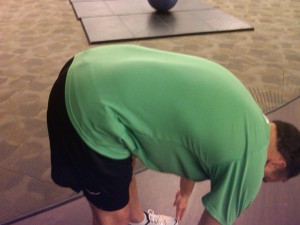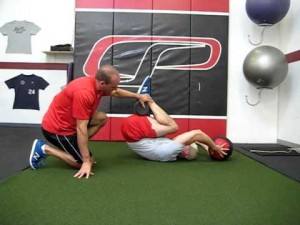Functional Stability Training
When I say “functional,” I’m sure people instantly think of standing on one foot on a bosu while spinning plates on their left hand and pulling an elastic with their right hand while reciting pie to 15 digits. While this will look cool to the unindoctrinated, it doesn’t mean you’re going to see any improvements in your ability to do anything that would be somewhat more sane and productive.
Let’s say you want to increase your shoulder stability. Performing a bench press would help that, even if it isn’t considered “functional.” The end result would be an increase in stability, therefore making it a functional exercise.
If you have fallen arches from lazy foot and ankle muscles, pulling a towel with your toes will make you look like a giant tool in any situation where not pulling a towel with your feet would be called upon and is probably one of the more useless exercises you could ever hope to do, but re-learning how to use your feet to form an arch during compound heavy lifts would help a lot more and make you stronger along the way.
Pickin up what I’m putting down?? Good.
When it comes to core training, it still boggles my mind when people use the phrase “core stability” to describe any and all methods of spinal flexion, extension, rotation and lateral flexion. The word “stability” doesn’t mean motion, it means the resistance of motion, and the resistance to motion in the presence of dynamic additions of resistance against the core so it has to respond and remain rigid. a lack of stability and an increase in motion during basic movement patterns is one of the biggest components to spinal injuries and limited performance.
Take for example a client who comes in with acute low back pain. When they perform a forward bend you notice that they begin the movement at their low back, use their hips only slightly and move through the range of motion as if they’re swimming in molasses instead of quickly and efficiently. When you ask them to point to the pain, they point right to the spot where you see the greatest amount of motion in their low back, or in other words the area where they look like their spine makes a 90 degree turn.
 Because of all these big glaring issues with the current state of core training, I’m really happy that Mike Reinhold and Eric Cressey have released their DVD workshop, Functional Stability Training. It has 3 modules to it, and the first one on core stability was released this week. I’m really happy witht he fact that Mike and Eric address what stability is and what it isn’t, and I spent the better part of Monday and Tuesday working my way through the module, and wanted to share with you some of the best points and reasons why you should get it to make your training produce better results and help clients become more bullet-proof than they already are.
Because of all these big glaring issues with the current state of core training, I’m really happy that Mike Reinhold and Eric Cressey have released their DVD workshop, Functional Stability Training. It has 3 modules to it, and the first one on core stability was released this week. I’m really happy witht he fact that Mike and Eric address what stability is and what it isn’t, and I spent the better part of Monday and Tuesday working my way through the module, and wanted to share with you some of the best points and reasons why you should get it to make your training produce better results and help clients become more bullet-proof than they already are.
Point #1: Training in a traditional strength program and training in a more “progressive” method of stability training produce gains in performance, but in slightly different ways when working on rehabbing injuries. Does this mean one is more right than another, or is there a missing link that requires both modalities to see the optimal advancement in health, performance, and return to optimal function? After all, the root word of “functional training” is function, or how the body accomplishes a task.
Point #2: Common core training staples like a plank, bird dog, rollout, and dead bug are commonly butchered in the persuit of making the exercise more advanced than it has to be, and to add more bells and whistles to these stripped-down fundamental movements.
Mike and Eric go through the mechanisms of how to do them PROPERLY, as well as the coaching cues and key pointers they use with their athletes. Keep in mind that they collectively work with close to a billion dollars in contracts for their athletes, as well as countless amateur and junior players, so they know a thing or two about what they’re doing. I can’t tell you how many times I’ve wanted to rip out what’s left of my hair after seeing someone perform one of these fundamental movements so ass-backwards and even been COACHED on how to do them poorly.
Point #3: I had no idea spondylolisthesis was such a big deal in youth athletes, but now I have some new ways of working with some of the clients whom I suspect may have this, as well as a way of making sure they get a training effect without increasing their risk of further injury.
Through my research of the general population, I’ve found that only about 20% of people would qualify for any type of spinal fracture issues, and this is in no way related to any scientific research, just me viewing the radiologist reports from over 300 clients who have gone in for imaging on acute or chronic low back pain. It would make sense that young athletes with limited motor control and engaging in high velocity rotational activities would potentially have a higher incidence of injury than the general population, but the degree of difference was definitely pronounced.
Point #4: Proper core training, especially in the presence of pain or dysfunction, cannot be done in a small- or large-group session. This isn’t because the exercise itself is boring or mundane in any way, but because the coach, trainer or therapist is going to be so involved in making sure the spine remains in neutral and that the client or patient is able to consistently activate their core in the right manner that they literally can’t work with anyone else effectively during this time.
I’ve found this as well, and all clients who are in need of post-rehab begin in a 1-1 setting with me, and have the possibility of graduating into small-group or semi-private, based on whether they are able to gain the necessary stability to perform key movements on their own without tactile or verbal feedback. Baby steps first, people.
Point #5: Should you train the rectus in isolation or in integration? Does it really matter? I don’t believe there is ever really a situation where you get purely one core muscle without co-activation of others, and if you by chance do, it will help to create an imbalance in the co-contraction around the spine, leading to more shear than compression, which will make the situation worse.
Instead of thinking about the individual muscles, think about the zones of the core, such as anterior, posterior and lateral. Make sure they breathe during all exercises so their diaphragm actually contributes and their pelvic floor is turned on so they don’t have an accident, and you’re good to go.
Point #6: Mike uses way better graphics and illustrative points than Eric, who uses a lot of text and can hammer home his points with way better live videos of his athletes getting after it in the gym. I got a lot out of both parts, but the presenter in me got a real charge out of seeing how Mike put his end together and how crisp and slick it was. Sorry Eric, Mike won that portion of the battle.
In all, Functional Stability Training of the core was a great seminar where I took a lot of great information away and made some tweaks to my own ability to train clients and alter my own training to get some more bang for my buck. I’d recommend anyone pick this up, but espeically anyone who works with clients or patients and needs to learn more about how to train the core in the best way possible. You have a simple choice: read MuscleMag and get all spine-flexion crazy, or get this and figure out how to get people a lot stronger without causing their discs to rip in half. Easy choice to me.
Oh, and one more thing. Until the end of the week they have it on sale, so you can save twenty bucks and only pay $77. That’s a seriously low cost for something this awesome.
=====> GET FUNCTIONAL STABILITY TRAINING NOW!! <=====


